(NASA) The Mysterious Rings Of Supernova 1987A Image Credit: ESA/Hubble, NASA
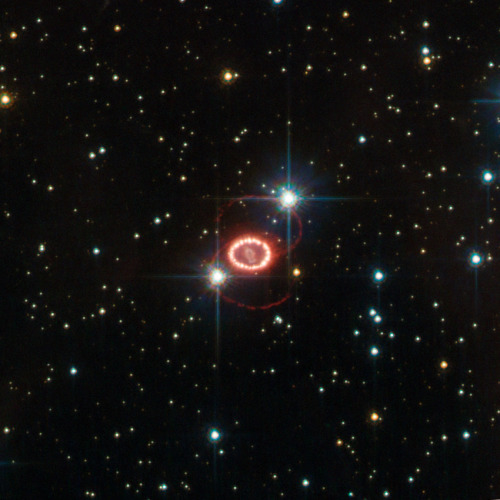
(NASA) The Mysterious Rings of Supernova 1987A Image Credit: ESA/Hubble, NASA
What’s causing those odd rings in supernova 1987A? Twenty five years ago, in 1987, the brightest supernova in recent history was seen in the Large Magellanic Cloud. At the center of the above picture is an object central to the remains of the violent stellar explosion. Surrounding the center are curious outer rings appearing as a flattened figure 8. Although large telescopes including the Hubble Space Telescope monitor the curious rings every few years, their origin remains a mystery. Pictured above is a Hubble image of the SN1987A remnant taken last year. Speculation into the cause of the rings includes beamed jets emanating from an otherwise hidden neutron star left over from the supernova, and the interaction of the wind from the progenitor star with gas released before the explosion.
More Posts from Sci-rei and Others

Spiral Galaxy NGC 1512: The Inner Ring
Most galaxies don’t have any rings – why does this galaxy have two? To begin, the bright band near NGC 1512’s center is a nuclear ring, a ring that surrounds the galaxy center and glows brightly with recently formed stars.
Most stars and accompanying gas and dust, however, orbit the galactic center in a ring much further out – here seen near the image edge. This ring is called, counter-intuitively, the inner ring. If you look closely, you will see this the inner ring connects ends of a diffuse central bar that runs horizontally across the galaxy.
These ring structures are thought to be caused by NGC 1512’s own asymmetries in a drawn-out process called secular evolution. The gravity of these galaxy asymmetries, including the bar of stars, cause gas and dust to fall from the inner ring to the nuclear ring, enhancing this ring’s rate of star formation. Some spiral galaxies also have a third ring – an outer ring that circles the galaxy even further out. ~ APOD
Credit: NASA, ESA, Hubble Space Telescope
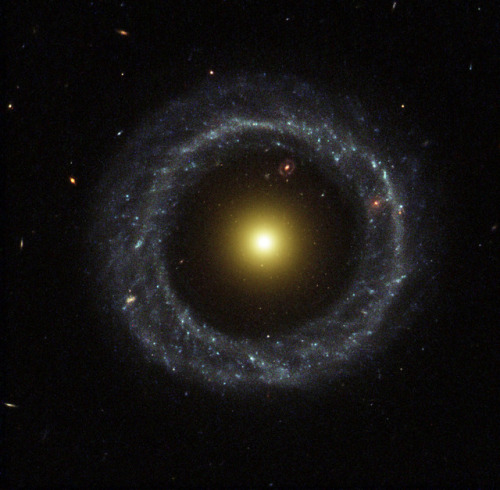
This is Hoag’s Object, a ring galaxy! Another red ring galaxy can be seen behind it.
via reddit

Why the Multiverse Isn’t Just Madness
Via Science Friday (gif by G VNCT)
On the thin and fragile frontier of physics, philosophy and science fiction, all of them based in different methodologies and fundamentals and with obvious different targets. On my part, I’m stick with physics, and this article make its points on pure theoretical physics. A good read.
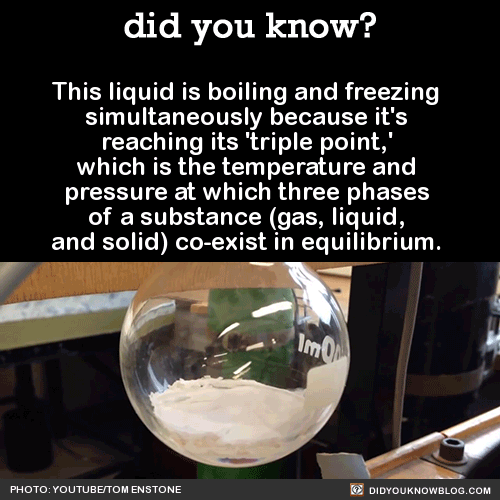
This liquid is boiling and freezing simultaneously because it’s reaching its ‘triple point,’ which is the temperature and pressure at which three phases of a substance (gas, liquid, and solid) co-exist in equilibrium. Source

Capillary action is the ability of a liquid to flow in narrow spaces without the assistance of, or even in opposition to, external forces like gravity. The effect can be seen in the drawing up of liquids between the hairs of a paint-brush, in a thin tube, in porous materials such as paper and plaster, in some non-porous materials such as sand and liquefied carbon fiber, or in a cell. It occurs because of intermolecular forces between the liquid and surrounding solid surfaces. If the diameter of the tube is sufficiently small, then the combination of surface tension (which is caused by cohesion within the liquid) and adhesive forces between the liquid and container wall act to lift the liquid.
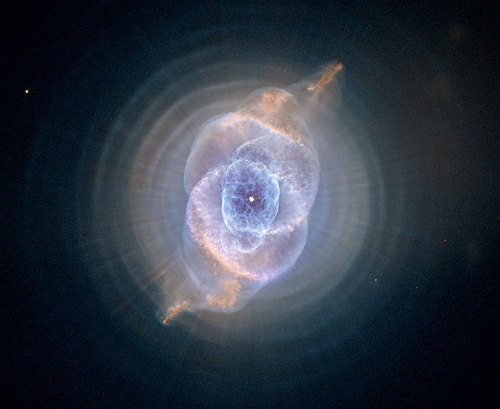
Cat’s Eye Nebula. Via APOD.
Credit: NASA, ESA, HEIC, and The Hubble Heritage Team (STScI/AURA)
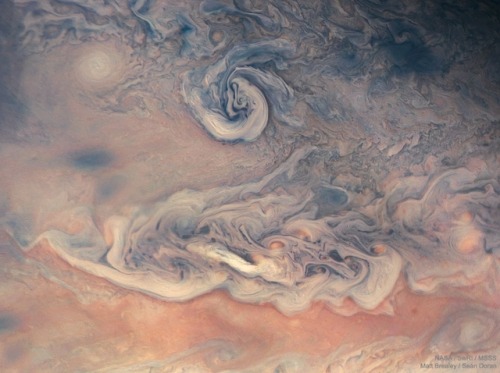
Juno captured the thick atmosphere (hydrogen, helium, small amounts of ammonium hydrosulfide) of Jupiter.
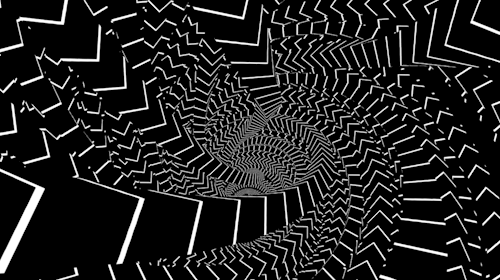
A mesmerizing gif who might entice you to read this interesting article about a regurgitating theory in particle physics, the Bootstrap model:
Quanta Magazine: Physicists Uncover Geometric ‘Theory Space’
Chew’s approach, known as the bootstrap philosophy, the bootstrap method, or simply “the bootstrap,” came without an operating manual. The point was to apply whatever general principles and consistency conditions were at hand to infer what the properties of particles (and therefore all of nature) simply had to be.
Gif by fellow Tumblr davidope
Also worth a reading the review of QM’s article in The Reference Frame: Revival of bootstrap
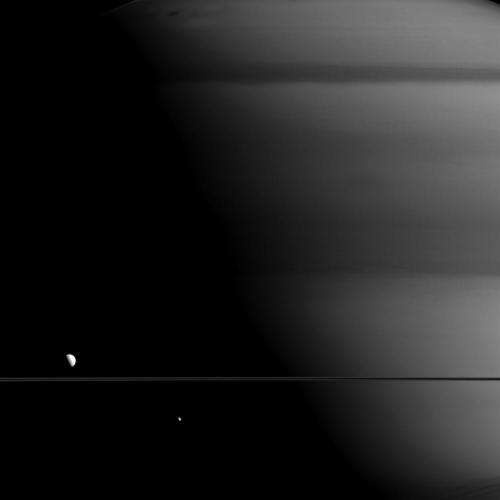
Two of Saturn’s Moons Standing in Sharp Contrast Against Their Giant Companion
via reddit
On Pirates and Astronomers

You must have seen pirates wearing eye patches on countless occasions. (although Captain Jack Sparrow does not for some reason)

But this has nothing to do with a missing eye (False Advertising), and everything to do with being able to see in the dark!
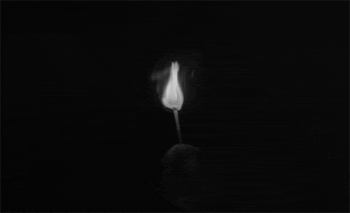
While the eyes adapt quickly when going from darkness to light, studies have show that it can take up to 25 minutes for them to adapt when going from bright light to darkness. This requires the regeneration of Photo Pigments.
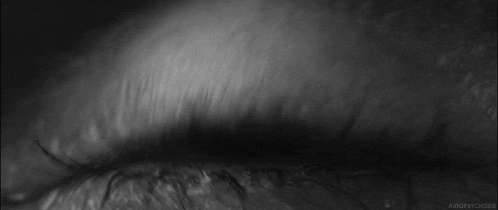
Pirates frequently had to move above and below decks, from daylight to near darkness, and they wore a patch over one eye to keep it dark-adapted outside.”

When the pirate went below decks, he could switch the patch to the outdoor eye and see in the darkness easily (potentially to fight while boarding and plundering another vessel).
Pirates are also smart, Arrr.
The 6 minute wait rule

It’s not a exactly a rule per se, but i am paraphrasing a friend who called it by that name, which is fairly accurate.
Astronomers (amateurs especially) can’t just swoosh out of their homes and expect to see the entire starry sky immediately. Their eyes have to become dark-adapted first and that takes time!
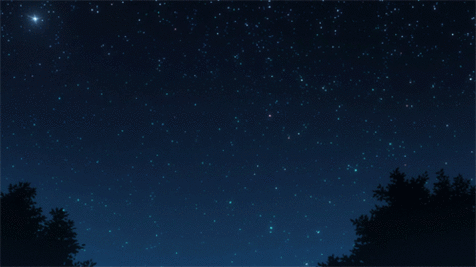
It takes a solid 30 minutes or so to get fully adapted, but within 6 minutes or so one can start to see prominent celestial objects. Hence the name of the rule.
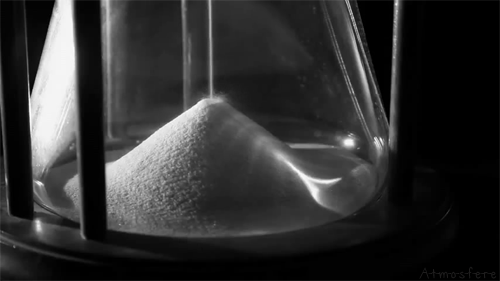
Ergo, if you stumble upon an astronomer, don’t ever flash a light at their faces. You will not hear the end of it!
Have a Good Day!

-
 sci-rei reblogged this · 7 years ago
sci-rei reblogged this · 7 years ago -
 8yearscounting-blog reblogged this · 7 years ago
8yearscounting-blog reblogged this · 7 years ago -
 ase23 liked this · 8 years ago
ase23 liked this · 8 years ago -
 miller-bot reblogged this · 8 years ago
miller-bot reblogged this · 8 years ago -
 alfssstuff liked this · 8 years ago
alfssstuff liked this · 8 years ago -
 hellisstyless reblogged this · 8 years ago
hellisstyless reblogged this · 8 years ago -
 readyfornothing liked this · 8 years ago
readyfornothing liked this · 8 years ago -
 unseenontv reblogged this · 8 years ago
unseenontv reblogged this · 8 years ago -
 stellaslunas-moved liked this · 8 years ago
stellaslunas-moved liked this · 8 years ago -
 theannoyingquestionsblog liked this · 8 years ago
theannoyingquestionsblog liked this · 8 years ago -
 interesting-mix reblogged this · 8 years ago
interesting-mix reblogged this · 8 years ago -
 contornidistorti-blog liked this · 8 years ago
contornidistorti-blog liked this · 8 years ago -
 kevelidon reblogged this · 8 years ago
kevelidon reblogged this · 8 years ago -
 kevelidon liked this · 8 years ago
kevelidon liked this · 8 years ago -
 starchaser-the-prophet liked this · 8 years ago
starchaser-the-prophet liked this · 8 years ago -
 markthespaceguy reblogged this · 8 years ago
markthespaceguy reblogged this · 8 years ago -
 prettythingspeacefulthoughts reblogged this · 8 years ago
prettythingspeacefulthoughts reblogged this · 8 years ago -
 mrgoodbytes87 liked this · 8 years ago
mrgoodbytes87 liked this · 8 years ago -
 unolespirit liked this · 8 years ago
unolespirit liked this · 8 years ago -
 jordanwby liked this · 8 years ago
jordanwby liked this · 8 years ago -
 thenightmareqveen reblogged this · 8 years ago
thenightmareqveen reblogged this · 8 years ago -
 raudran liked this · 8 years ago
raudran liked this · 8 years ago -
 photonic-pulsar liked this · 8 years ago
photonic-pulsar liked this · 8 years ago -
 spookstowne liked this · 8 years ago
spookstowne liked this · 8 years ago -
 irish303lkwd liked this · 8 years ago
irish303lkwd liked this · 8 years ago -
 spacemonkee reblogged this · 8 years ago
spacemonkee reblogged this · 8 years ago -
 yorthos liked this · 8 years ago
yorthos liked this · 8 years ago -
 madxam reblogged this · 8 years ago
madxam reblogged this · 8 years ago -
 victorylilygreen liked this · 8 years ago
victorylilygreen liked this · 8 years ago -
 kholexcx liked this · 8 years ago
kholexcx liked this · 8 years ago -
 keepuppuff liked this · 8 years ago
keepuppuff liked this · 8 years ago -
 treegourds liked this · 8 years ago
treegourds liked this · 8 years ago -
 zetarays reblogged this · 8 years ago
zetarays reblogged this · 8 years ago -
 derekmayfire reblogged this · 8 years ago
derekmayfire reblogged this · 8 years ago -
 captainsaltymcsalt-blog liked this · 8 years ago
captainsaltymcsalt-blog liked this · 8 years ago -
 fuckyeahcelestialthings reblogged this · 8 years ago
fuckyeahcelestialthings reblogged this · 8 years ago -
 holesinrealityy reblogged this · 8 years ago
holesinrealityy reblogged this · 8 years ago -
 holesinrealityy liked this · 8 years ago
holesinrealityy liked this · 8 years ago